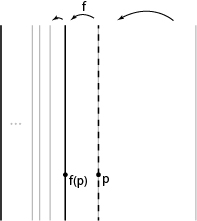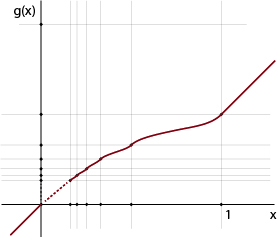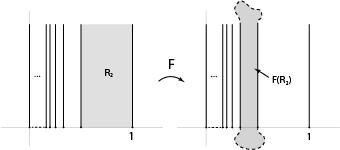One of the things I’ve always been interested in is, for a given compact set say in , what maps defined on the set into
can be extended to a volume preserving map (of certain regularity) on a larger set (for example, some open set containing the original set).
The analogues extension question without requiring the extended map to be volume preserving is answered by the famous Whitney’s extension theorem. It gives a beautiful necessary and sufficient condition on when the map has extension – See this pervious post for more details.
A simple case of this type of question was discussed in my earlier Moser’s theorem post:
Question: Given a diffeomorphism on the circle, when can we extend it to a volume preserving diffeomorphism on the disc?
In the post, we showed that any diffeomorphism on the circle can be extended to a
volume preserving diffeomorphism on the disc. Some time later Amie Wilkinson pointed out to me that, by using generating function methods, in fact one can avoid losing derivative and extend it to a
volume preserving.
Anyways, so we know the answer for the circle, what about for sets that looks very different from the circle? Is it true that whenever we can extend the map, we can also so it volume-preserving? (Of course we need to rule out trivial case such as the map is already not volume-preserving on the original set or the map sends, say a larger circle to a smaller circle.)
Question: Is it true that for any compact set with connected complement, for any function
satisfying the Whitney condition with all candidate derivatives having determent
, one can always extend
to a volume preserving
.
Note: requiring the set to have connected complement is to avoid the ‘larger circle to small circle’ case and if some candidate derivative does not have determent then the extended map cannot possibly be volume preserving near the point.
After thinking about this for a little bit, we (me, Charles and Amie) came up with the following simple example where the map can only be extended but not
volume preserving.
Example: Let be the countable union of segments:
As shown below:
Define be the map that sends the vertical segment above
to the vertical segment above
, preserves the
-coordinate and fixes the segment
:
Claim: can be extended to a
map
.
Proof: Define s.t.
1) is the identity on
2) for
3)
4) is increasing and differentiable on each
with derivative no less than
and the one sided derivative at the endpoints being
.
It’s easy to check such exists and is continuous:
Since , we deduce
is continuously differentiable with derivative
at
.
Let ,
is a
extension of
.
Establishes the claim.
Hence the pair satisfies the Whitney condition for extending to
map. Furthermore, since the
as above has derivative being the identity matrix at all points of
, the determent of candidate derivatives are uniformly
. In other words, this example satisfies all conditions in the question.
Claim: cannot be extended to a
volume preserving diffeomorphism of the plane.
Proof: The idea here is to look at rectangles with sides on the set , if
preserves area, they have to go to regions enclosing the same area as the original rectangles, then apply the isoperimetric inequality to deduce that image of some edges of the rectangle would need to be very long, hence at some point on the edge the derivative of
would need to be large.
Suppose such extension exists, consider rectangle
. We have
Hence in order for to have the same area as
, the image of the two segments
and
would need to enclose an area of outside of the rectangle
.
By isoparametric inequality, the sum of the length of the two curves must be at least , while the length of the original segments is
.
Hence somewhere on the segments needs to have derivative having norm at least
We deduce that there exists a sequence of points converging to either
or
where
.
Hence cannot be
at the limit point of
.
Remark: In fact we have showed the stronger statement that no volume preserving Lipschitz extension could exist and gave an upper bound on the best possible Holder exponent.
From this we know the answer to the above question is negative, i.e. not all extendable map can me extended in a volume preserving fashion. It would be very interesting to give criteria on what map on which sets can be extended. By applying same methods we are also able to produce an example where the set
is a Cantor set on the plane.




Oh god. I just noticed that it is about Whitney extension, not ’embedding’.
LikeLike
Should the tag “isoparametric inequality” be “isoperimetric”?
LikeLike
Haha…Oh yes…thanks^^ (now I know why spellcheck didn’t know that word>.<) and unfortunately I have just sent an e-mail containing the word 'isoparametric' -_-b|||
LikeLike
[…] C^1 vs. C^1 volume preserving […]
LikeLike